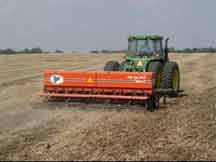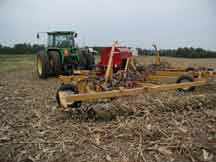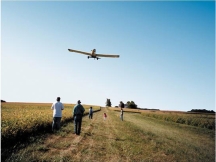Planting Annual Ryegrass as a Cover Crop
Annual ryegrass as a cover crop has more than a decade of success in the Midwest. Success is measured by increased soil quality, increased crop yields and reduced costs. There are, however, several management decisions needing consideration, all of which affect the likelihood of a successful experience.
Seeding date – The ideal time to plant annual ryegrass is from the middle of August to the end of September, after harvest. Seeding up to mid October is possible but more weather dependent, especially the further North you are. Annual ryegrass will germinate in 7-10 days with sufficient soil moisture. Dry soil conditions will delay germination. Ideally annual ryegrass needs 60 days of growth before a hard killing frost.
Seeding methods – There are several ways to plant annual ryegrass:
Using a Drill to Seed Annual Ryegrass – Drilling seed after harvest. The preferred method to seed annual ryegrass is with a no-till drill (main box works fine) about ¼ to 3/8 inch deep. This provides optimal seed to soil contact.

Broadcasting – Mix seed with fertilizer and use an airflow truck. Running a fluffing harrow (like a Phillips or Phoenix harrow) after the airflow will throw some residue and soil over the seed, improving the seedbed and increasing the likelihoood of germination.

Seeding Annual Ryegrass with a Rolling Harrow
Mixing annual ryegrass seed with fertilizer and broadcasting it using a spinner truck or buggy is an option, but annual ryegrass seed is lighter than fertilizer and will not spread as far with a spinner. To avoid skips and gaps, split the middles to get more uniform application.
Some farmers have tried coated annual ryegrass with success. Though the price is higher for seed, the grower can save by using fewer pounds of seed per acre.
Seed application with manure slurry. Farmers with livestock are increasingly seeding annual ryegrass along with manure in the fall. In some cases, grazing in the fall and spring can cut feed costs while improving livestock health and soil quality.
Aerial seeding – into a standing crop just prior to leaf drop is an option, especially in years when harvest is delayed well into the fall. Applying with fixed wing aircrafts is preferrable to helicopters, especially when the airport is close to the farm. Helicopters have some advantages but the application is not as consistent, due to prop wash.

Aerial Seeding Ryegrass with Aircraft
If applying seed aerially, it’s important to find a pilot with experience because air speed and altitude need to be precicely calibrated to the application rate and the type of diffuser used.
Dormant Seeding – is done after the field has frozen for the winter. This is not the most ideal form of applying a cover crop, but it’s better than no cover whatsoever.
Once thaw arrives, the heaving action of the topsoil will work the annual ryegrass seed into the soil, enhancing its viability for growth.
With dormant seeding, it may be advisable to allow the annual ryegrass additional time to grow in the spring, before killing it with herbicide. For this reason, planting soybeans after a dormant seeded field makes more sense.
Seeding rate – Annual ryegrass is normally seeded at 12-15 lbs/ac (15 lbs/ac most common) if using a drill. Increase the seeding rate to 20-25 lbs/ac if broadcasting, aerial seeding or dormant seeding. When setting drills to seed annual ryegrass, use the recommended setting for tall fescue at 15 lbs/ac. This is the equivalent of 20 lb/ac for annual ryegrass.
Winter annual weed control – If winter annuals are present at planting time, use a burndown herbicide (Roundup and/or 2,4-D) prior to planting the annual ryegrass. If not, winter annuals will compete aggressively with the cover crop the following spring.
Nitrogen – Nitrogen will stimulate annual ryegrass fall growth. Apply 30 lbs/ac of Nitrogen (200 lb of DAP works well). This is especially important if seeding in October. However, if manure has been applied in the last 2-3 years or the field has been in continuous no-till for 3-5 years, and seeded timely, the fall nitrogen may not be needed.
Expected growth – If properly seeded (instructions above followed) one can expect to see 2- inches of top growth before a hard killing frost. Early planting, good growing conditions and sufficient N may result in more fall growth (8-16 inches). In that case, grazing or cutting for green chop is desirable with this much growth. Snow cover in northern areas will help protect annual ryegrass from winterkill. Even a thin stand with little fall growth may tiller and with good spring weather conditions, the stand may be 4-8 inches tall by the second week of April, generally the proper time for the burndown to be applied.
Caution – Annual ryegrass may become a weed without proper management. Avoid using annual ryegrass in fields with wheat in the crop rotation unless a high level of management is used. Annual ryegrass should never be allowed to head out and go to seed.
